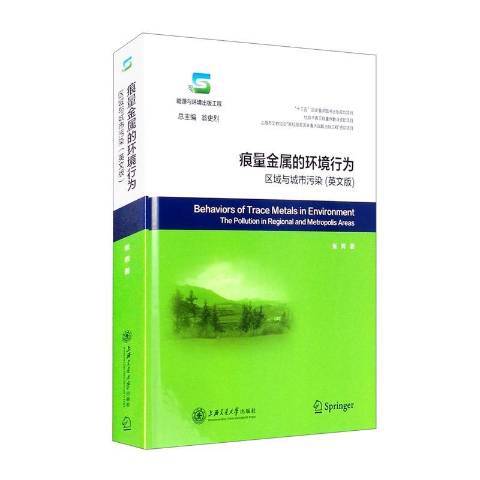《痕量金屬的環境行為區域與城市污染》是2020年上海交通大學出版社出版的圖書。
基本介紹
- 中文名:痕量金屬的環境行為區域與城市污染
- 作者:張輝
- 類別:社會科學
- 出版社:上海交通大學出版社
- 出版時間:2020年
- 開本:16 開
- 裝幀:精裝
- ISBN:9787313233448
內容簡介,圖書目錄,作者簡介,
內容簡介
本書研究工作受國家自然科學基金委員會及國際(美國、日本)科研協作項目基金等多家基金部門資助,在多年探索積累基礎上,對具典型代表意義的不同成因污染案例—黃河河套地區區域性痕量金屬污染和上海市、南京市現代城市發展中的痕量金屬污染的污染現象、環境效應、以及污染物行為規律進行歸納總結。通過對不同成因背景案例中痕量金屬污染過程和現象的具體研究工作,對各類污染的污染物特徵、制約因素、成因過程和演化趨勢進行剖析討論,以探索痕量金屬污染的規律性事實。
圖書目錄
Chapter 1 Introduction
1.1 The Trace Metals and the Study History
1.2 The Objects of This Work
1.2.1 The Regional Trace Metal Behavior and Pollution Research Case
1.2.2 The Metropolis Trace Metal Behavior and Pollution Research Cases
1.3 The Methods of This Work
1.3.1 Sample
1.3.2 Analysis and Test of Composition
1.3.3 Simulation Experiments on Desorption and Sorption
of Trace Metals from or on the Medium
1.3.4 The Speciation Analysis Experiment of Trace Metals
1.3.5 Analysis and Testing Precision and Quality Index
References
Chapter 2 The Regional Pollution of Trace Metals——The Hetao Area China
2.1 The Geochemical Setting of the Study Area
2.2 The Distribution of Trace Metals in the Soil
2.2.1 The Distribution of Total Concentration of Trace Metals
2.2.2 The Distribution of Speciation of Trace Metals
2.3 The Distribution of Trace Metals in the Groundwater
2.3.1 The Distribution of Arsenic
2.3.2 The Distribution of Cu,Zn,Cd,Sb,and Pb
2.4 The Distribution of Trace Metals in the Resident Hair of the Area
2.4.1 The Progress of the Research on Trace Metals in Human Hair as an Environmental Indicator
2.4.2 The Distribution of Trace Metals in the Resident Hair of the Hetao Area
2.4.3 The Relationship Between the Trace Metals in the Resident Hair and that in the Water and Soil of the Hetao Area
2.5 Study on the Isotope Tracing for Trace Metals in the Soil and Groundwater
2.5.1 Samples
2.5.2 The Distribution of Pb and Sr Isotope in the Soil and Groundwater
2.5.3 The Discussion of the Pb and Sr Isotope in the Soil and Groundwater
2.6 Discussion on the Distribution, Environmental Impacts,and Evolution Trends for Trace Metals in Soil and Groundwater
2.6.1 The Correlation of the Concentration Distribution of Trace Metals Between Soil and Groundwater
2.6.2 The Difference and Correlation for the Distributions of Trace Metals Between the Soil and Groundwater
2.6.3 The Evolution and Factors of the Trace Metal Pollution in Study Area
References
Chapter 3 The Metropolis Pollution of Trace Metals——-Shanghai and Nanjing, China
3.1 The Pollution of the Trace Metals in Urban Rivers
3.1.1 The Pollution of Trace Metals and Organic Matter (PCBs) from the Suzhou Creek, Shanghai
3.1.2 The Pollution of Trace Metals and Organic Matter (PAHs) from the Huangpu River, Shanghai
3.1.3 The Trace Metal Pollution in the Nanjing Section of the Yangtze River
3.2 The Pollution of the Trace Metals in Urban Lake, Shanghai
3.2.1 The Distribution, Pollution, Spatial, and Temporal
Changes of the Trace Metals of the Dianshan Lake
3.2.2 The Coupling Relationship of Levels of Trace Metals, N,P,C,and Pesticides in the Dianshan Lake
3.2.3 The Implication from the Coupling Features of the Trace Metals, N, P, C, and Pesticides in the Sediment of the Dianshan Lake
References
Chapter 4 The Experimental Research on the Behaviors of Trace Metals
4.1 The Objectives, Research Idea, and the Approach Design for the Experiments
4.1.1 The Objectives of the Research
4.1.2 The Approach Design for the Experiments
4.2 The Simulated Experiments on the Desorption and Adsorption Behaviors of the Trace Metals in the Soil
4.2.1 The Simulated Experiments on the Desorption and
Adsorption Behaviors of Trace Metals in the Regional Pollution Soil
4.2.2 Discussion on the Facts Revealed by the Experiments
4.3 The Simulated Experiments on the Release Mechanism of Trace
Metals to Environment from Natural Substances Rock or(Mineral)
4.3.1 The Simulated Experiment on the Trace Metal
Desorption from Particles (Rock, Mineral) at the Earth Surface Conditions
4.3.2 Results and Discussion
References
Chapter 5 Probing into the Speciation of Trace Metals and Research Methods
5.1 The Significance and Developing Trends of the Research on Trace Metal Speciation
5.1.1 The Concept of the Trace Metal Speciation
5.1.2 The Trace Metal Speciation Analysis Methods and
Mechanisms
5.1.3 The Questions in Speciation Analysis of Trace Metals
5.2 The Pertinence on the Analysis Procedures of the Speciation Analysis for Trace Metals
5.2.1 The Speciation Analysis for the Trace Metals Dissolved in Water and Contained in Particulates
5.2.2 The Speciation Analysis for the Trace Metals in the Soil
5.2.3 The Method for Speciation Analysis of Trace Metals Used in This Work
5.3 Suggestions and Improving on the Trace Metal Speciation
Analysis Procedures, the Method of Three-Step Speciation
Analysis
5.3.1 The Meaning of the Method of Three-Step Speciation
Analysis (Three-Step Procedure)
5.3.2 The Proposal of the Three-Step Procedure
5.3.3 The Comparison Experiments Between the Results
Obtained Respectively from the Mainstream and the Three-Step Procedure Analysis Methods
5.3.4 The Significance and Application of the Three-Step Procedure Method on Trace Metal Speciation
Analysis
References
Chapter 6 Main Conclusions and Perspectives on the Work
6.1 The Environmental Behaviors and Pollution of the Trace Metals
in Area Pollution
6.1.1 The Case Studies of Trace Metals and Pollution in Soil
and Groundwater
6.1.2 Formation Mechanism of Regional Trace Metal Pollution
and Its Behavior in Related Media
6.2 The Environmental Behaviors and Pollution of the Trace Metals
in the Modem Metropolises
6.2.1 The Behavior and Pollution of Trace Metals in Urban
Rivers
6.2.2 The Behavior and Pollution of Trace Metals,in Urban
Lakes
6.3 Some Significant Behaviors and Relative Features of Trace
Metals in Environment
6.3.1 Major Differences and Relations Between Natural Trace
Metal Pollution and Artificial Trace Metal Pollution
6.3.2 The Simulation Experiments on the Mechanism of Trace
Metal Behavior and Pollution
6.4 The Probing and Improving on the Research Methods for the
Trace Metals in Environments
6.5 The Perspectives on This Study
References
作者簡介
張輝,南京大學理學博士,上海交通大學環境科學與工程學院副教授,美國化學會、 國際醫學地質協會會員。研究方向為污染物行為化學,污染同位素計時、示蹤。主持包括國家自然科學基金、國際協作研究基金等國家及省部級投資、資助項目10餘項。'

